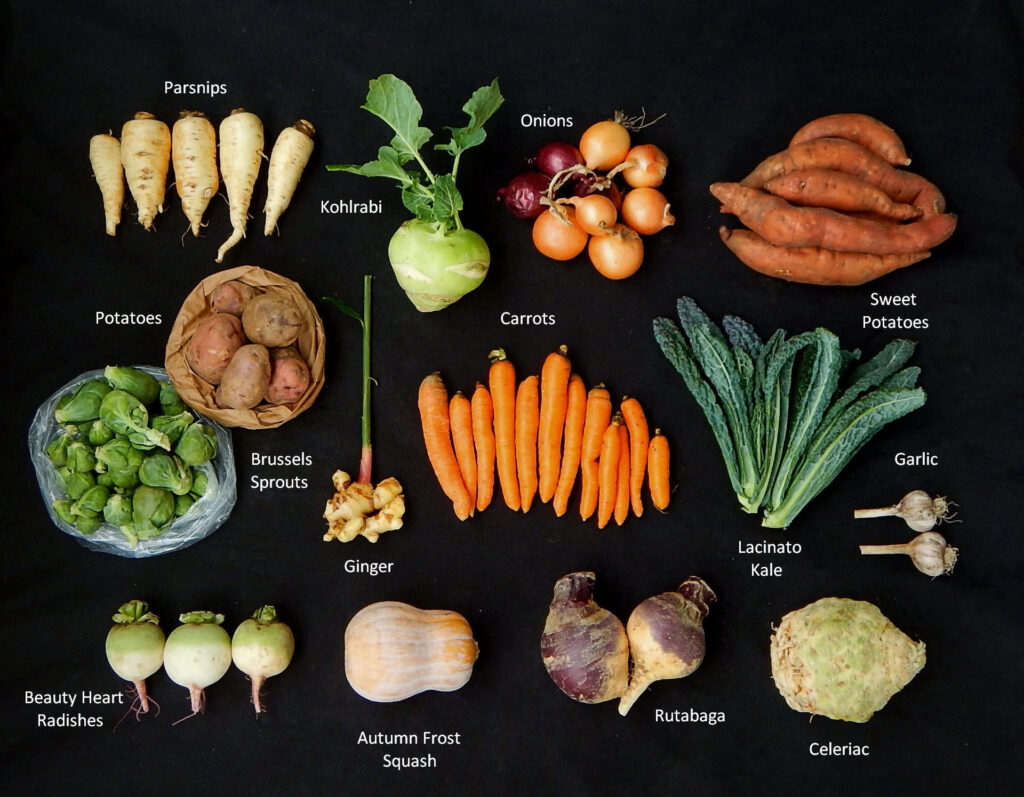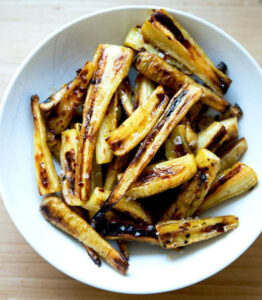What’s In The Box with Recipe Suggestions
Brussels Sprouts: For the longest storage potential, keep Brussels sprouts in the refrigerator in the plastic bag they are packed in. When you are ready to use them, trim the base of the sprout a bit and peel away any outer leaves that may be yellowing.
Brussels Sprouts Risotto Ottolenghi
Shredded Brussels Sprouts and Bacon Pizza
Orange Carrots: Store carrots in the refrigerator in the plastic bag they come in. Give them a scrub before using it. Peeling is optional.
Cranberry-Cider Braised Beef Stew with Rosemary Polenta
Celeriac: This is the gnarly looking roundish root vegetable in your box. Its exterior is bumpy, and the peeling should be removed prior to use. You may notice some small black spots near the bottom portion of your celeriac. These spots are minimal, going an inch or less into the celeriac. They can easily be cut out and around.
Celery Root Stuffing with Roasted Meyer Lemons
Classic French Celeriac Remoulade
Italian Garlic: Pair this week’s garlic with some of the ginger in this healing and nourishing Ginger Garlic Soup.
Garlic Parmesan Sweet Potato Fries with Spicy Aioli
Fresh Baby Ginger: Fresh baby ginger has thin skin and is more delicate than ginger you may purchase at the store. As such, it is best to use it within one week to take full advantage of its fresh, juicy flavor! Store it at room temperature for up to a week. If you are not going to use it within one week, it may be frozen in its raw state for later use.
Gingery Sesame Noodles (Substitute Kale for the spinach)
Daikon Radish & Soba Noodle with Chickpea Miso Ginger Sauce
Ginger Vegetable Smoothie Recipe
Lacinato Kale Tops: We finish our Kale season by cutting the tops off all the plants, so if you’re wondering why the leaves aren’t bunched, this is why. This kale has been through some very cold nights and was totally frozen. The result—excellent, sweet flavor!
Quinoa and Kale Veggie Quesadillas
Kohlrabi: This variety of kohlrabi is intended for storage and will last well into the winter. Peel away the exterior to find the crispy, crunchy, slightly sweet flesh inside.
Red & Yellow Onions: This week’s varieties are intended for long term storage. It’s best to store onions in a cool, dry location and out of direct sunlight. If you notice one starting to sprout, it’s time to use that onion!
Breakfast Strata with Mushrooms and Caramelized Onions
Roasted Sweet Potatoes, Caramelized Onions & Goat Cheese
Parsnips: Parsnips grow in a variety of sizes, so you may receive small parsnips or larger ones! Small parsnips may be cooked whole or cut in half. If you have a variety of sizes in your box this week, try to cut the parsnips into similar sized pieces for more even cooking.
20 Minute Honey Roasted Parsnips
Puréed Parsnip & Cardamom Soup with Caramelized Shallots
Root Vegetable Gratin with Sweet Potatoes, Parsnips, and Beets
Purple Viking Potatoes: This potato variety is considered to be an “all-purpose” potato. It has dark purple skin that has splashes of pink with white flesh. This potato can be used for pretty much anything from soups, fries or even mashed potatoes!
Sausage, Kale & Potato Skillet Dinner
Beauty Heart Radishes: This is classified as a winter storage radish and can be stored for several months. The exterior is a light cream to green color. When you cut it open, you’ll find vibrant, bright, pink flesh inside. They are most commonly eaten raw, but you can also add them to soups and stews or roast them. Beauty heart radishes have more of a mild and slightly sweet radish flavor. If you find they are a little too intense for your taste, you may wish to peel them as a lot of the radish flavor is in the outer skin. Cooking also mellows the intensity of the radish flavor and brings out the sweetness.
Watermelon Radish Toast with Miso-Honey Butter
Beauty Heart Radish Toast with Cream Cheese, Lemon and Honey
Rutabaga: Rutabagas are a dense vegetable with a yellowish-buff colored skin with purple around the top. They are a simple vegetable that may be added to soups and stews, cooked with other roots and potatoes to make a root mash, or you can even eat them raw in winter salads! Store them in the refrigerator loosely wrapped in a plastic bag to prevent dehydration.
Rutabaga & Apple Salad (Kålrabi Salat med Epler)
Sweet Potatoes: This week’s variety is the well-known Covington, which is characterized by more of an orange skin. It’s best to store sweet potatoes at a temperature of about 55-65 degrees. If you don’t have a cool, dry location to store them in, just store them at room temperature in your kitchen. Do not store them in the refrigerator.
Bourbon Sweet Potato Casserole with Sweet N Savory Bacon Pecans
Simple, Salty Sweet Potato Skin Chips
Oatmeal Raisin Sweet Potato Cookies
Root Vegetable Gratin with Sweet Potatoes, Parsnips, and Beets
Autumn Frost Squash: Autumn Frost is a more decorative version of its cousin, the butternut. This variety may be used interchangeably in any recipe calling for Butternut as you’ll find the flesh has the same color, consistency and flavor as butternut. We have found this squash to be sweet and delicious while also having good long term storage potential!
Fluffy Butternut Squash Rolls with Sage
No Bake Pumpkin Pie Cheesecake
Vegetable Feature: Parsnips

Parsnips fill an important place in our seasonal diets because of their ability to store well through the winter, both in our refrigerators as well as in the field. Parsnips are one of our largest crops. Parsnips are a challenging crop to grow because their seeds take about 2 weeks to germinate and we have to plant them early in the spring when the soil is still cold. They also have a very long growing season which means more management in the field to keep them healthy and keep the weeds under control. Parsnips are often described as being a white carrot. While they do resemble carrots, they are not really just a white carrot. They have a distinct flavor that is much different from carrots. They also have the ability to survive if we leave them in the field over the winter. We’ll harvest most of this year’s crop this fall, but we will leave some parsnips in the field with plans to harvest them next spring. It’s a little risky, but parsnips can be overwintered in the field and when we dig them in the spring they are even more sweet and delicious than they are this fall!
Parsnips are a versatile vegetable that can be prepared in a variety of ways. Their sweetness really comes out when they are roasted, which is one of our favorite ways to prepare parsnips. They also make a nice addition to a fall root mash or mix them with other vegetables in hearty soups and stews. You can also use them in baked goods, similar to how you might use carrots. We have used them to make parsnip muffins that are similar to carrot cake. You can also use them to make quick bread or even cookies.
Parsnips pair very well with other root vegetables, wine, shallots, apples, walnuts and a variety of spices including cinnamon, nutmeg, cardamom and ginger. Some people really like the distinct flavor of parsnips, while others may still be learning to like them. If you’re in the latter group, we recommend that you start by using parsnips in baked goods or use them in small quantities mixed with other vegetables in soups, stews or a simple root mash.
Store parsnips in the coldest part of your refrigerator in a plastic bag. They will store for several weeks under these conditions, so don’t feel like you need to eat them all right now. When you are ready to use them, scrub the outer skin with a vegetable brush and trim off the top and bottom. If you are making puréed parsnip soup and want it to be snow white, we do recommend peeling the parsnips. If you aren’t looking for an art display presentation, skip the peeling part of the process.
Short & Sweet Weekly Farm Update
This week we say ‘see you next spring’ to 8 more crew members. While we are still harvesting some winter radishes, we have tucked in our garlic for the winter. Meaning, we have all the garlic mulched, covered and fenced to keep the deer out of there this winter. We still have to mulch the strawberries and double cover the spinach, that we will use in the spring as overwintered spinach!
We have harvested all of the parsnips we need for the winter and left an estimated 9,000 pounds to overwinter and be dug in the spring for CSA boxes. We don’t cover the parsnips, but we do have to fence and monitor the field all winter. Those pesky deer really like to dig and eat our parsnips whenever they can get in the field!
Other projects include washing, repairing and putting the implements for winter storage. We have cleared away many Walnut trees that were encroaching on our fields. That means we have some very beautiful wood available for your woodworking projects!



